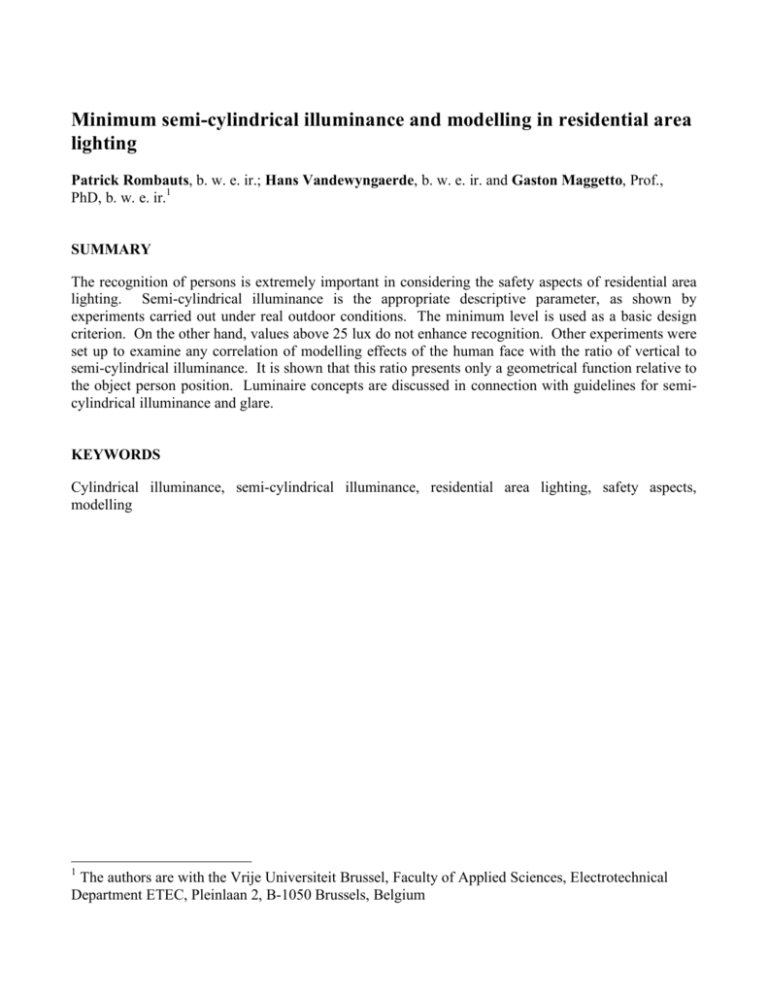Minimum semi-cylindrical illuminance and modelling in residential
advertisement

Minimum semi-cylindrical illuminance and modelling in residential area
lighting
Patrick Rombauts, b. w. e. ir.; Hans Vandewyngaerde, b. w. e. ir. and Gaston Maggetto, Prof.,
PhD, b. w. e. ir.1
SUMMARY
The recognition of persons is extremely important in considering the safety aspects of residential area
lighting. Semi-cylindrical illuminance is the appropriate descriptive parameter, as shown by
experiments carried out under real outdoor conditions. The minimum level is used as a basic design
criterion. On the other hand, values above 25 lux do not enhance recognition. Other experiments were
set up to examine any correlation of modelling effects of the human face with the ratio of vertical to
semi-cylindrical illuminance. It is shown that this ratio presents only a geometrical function relative to
the object person position. Luminaire concepts are discussed in connection with guidelines for semicylindrical illuminance and glare.
KEYWORDS
Cylindrical illuminance, semi-cylindrical illuminance, residential area lighting, safety aspects,
modelling
1
The authors are with the Vrije Universiteit Brussel, Faculty of Applied Sciences, Electrotechnical
Department ETEC, Pleinlaan 2, B-1050 Brussels, Belgium
1. Introduction
Public lighting design, as based upon car-driver
oriented concepts, does require changes in
perspective, especially within zones with a
considerable presence of slow moving
observers
(pedestrians,
cyclists
and
occasionally moped riders).
Lighting for motorways, with their high density
and speed of cars, only considers observers
from the driver's point of view; "personal"
contact between them is obviously non-existent.
These concepts have been extrapolated, more or
less, to other applications in outdoor lighting
where cars are still present, but in a minor role.
Recently however, the new architectural
concept of the "woonerf" [1] has been
introduced, as part of the tendency to accord the
pedestrian a principal role with stress on quality
of living conditions. This changed "modus
vivendi" has undoubtedly affected other, more
classically conceived residential areas and
pedestrian zones (such as commercial centres,
walkways, parks, etc.) as regards the design of
the lighting installation.
In this paper the pedestrian remains the
observer as an individual.
All things
considered, he is the most vulnerable subject on
the scene. With regard to the safety aspect,
which we may consider as a main theme, one
ought to position the observer in the most
unfavourable situation in order to deduce the
measures to be taken to guarantee safety of
persons and property.
Obviously, the fundamentals of residential area
lighting can be recovered in the broader matter
of public lighting. Analogous elements are
being in the open, the configuration of streets
and environment, the use of outdoor luminaires
suspended from light-poles, etc.
There is undeniably a dialectic between the
inside (interior) and the outside (outdoor)
world, between the closed and the open space;
as revealed by the French philosopher Gaston
Bachelard in "La poétique de l'espace" [2].
Even so it may appear paradoxical that the
basic design of outdoor area lighting involving
pedestrians, as observed from pedestrian's point
of view, correlates with fundamental criteria for
interior lighting : it is evident that the ability of
recognition of a human face and other patterns,
and the estimation of a person's intentions play
as well an extremely important role within
residential areas. Interior lighting is considered
here as more than aesthetics within private
houses.
Residential areas involve human psychology in
such a way that adequate lighting contributes
substantially to a comfortable ambient
atmosphere for residents moving outside their
premises, and for non-residents entering
unfamiliar surroundings after dark.
People are involved as individual human
beings. The phenomenon of seeing in its
totality is not translatable to a measurable
quantity; the most we can attempt is to use
descriptive parameters.
2. Summary of lighting criteria
Van Bommel and Caminada [3],[4] are the
main contributors to a novel approach to the
lighting of residential areas.
These criteria are mainly based upon concepts
of illuminance, though one does not "see" in
terms of illuminances. Exceptionally, with
dedicated routes for mopeds and bicycles the
luminance concept is used. But as here a
description of an entire scene is needed, we do
have to work with "easy-to-handle" parameters.
Clearly, this scene becomes more diverse in
quality of materials (concrete, tiles, grass,
gravel, bushes, etc. in different aspects) the
more important the living and destination
function is considered.
What is more, from pedestrian's point of view
(or other slow moving observers), viewing
directions are distributed over the entire space;
the visual field cannot be determined in a
singular way, and may cover several objectives
of interest at the same time.
The lighting criteria can be summarised as
follows :
(a) Perception of obstacles and objects,
especially near ground level;
(b) Visual orientation, overall impression of
environment, safety of properties;
(c) Recognition and identification of persons
and their intentions, safety aspects;
(d) Glare restriction;
Particular stress is laid here on the threedimensional forms of illuminances2, which may
be of some interest with regard to the
recognition of a human face, and other objects
with a spatial character or a definite shape.
3. Semi-cylindrical illuminance ESC
Gutorov [5] defined the mean cylindrical
illuminance (ECyl) as a new concept and
Epaneshnikov et al. [6] related it to the lighting
of places with a high density of pedestrians and
with an "open" character, such as railway and
underground entrance halls, exhibition rooms,
congress meeting halls, etc.
The concept of ESC was only recently
introduced in design of sports lighting for
colour television capture [7] and in the design
of interior lighting where people should be able
to communicate with each other and where
"spatial restoration" of objects is a necessity.
Briefly, ESC is defined as the averaged
illuminance on the curved surface ASC of an
upright half cylinder. (See Figure 1) :
(e) Visual comfort (modelling effects, nature of
the light source, light penetration into private
houses, visual impact of the installation, etc.);
(f) Economical operation of luminaires and
exploitation of installation from illuminating
point of view, æsthetical outlook, maintenance
aspects.
All this needs to be quantified in terms of
descriptive lighting parameters, such as
illuminances (horizontal, vertical, hemispherical,
semi-cylindrical);
luminances;
intensities; ratios of illuminances; other
parameters.
where Φ is the luminous flux on the half
cylinder, ASC is the curved surface, and EV(ϕ) is
the vertical illuminance as a function of ϕ.
2
During the last CIE Session in Venice (1987) the new
Technical Committee on "Three-dimensional forms of
illuminance" (CIE TC 3-14) was inaugurated, under the
chairmanship of Kit Cuttle (NZ).
A preliminary series of experiments was set up
to examine the way in which an assembly of
luminaires in the field contributes to
recognition capability. This was done by
switching on and off combinations of the
luminaires in the street. The test conditions are
largely as in section 4.2.
Figure 1 : Definition of semi-cylindrical
illuminance
As the light flux collected by the (infinitely
small) half cylinder has an integral character
one has to bear in mind that ESC cannot
represent the distribution of light completely.
When the proper "flow of light" needs to be
characterised, the vector/scalar concept of
illuminance is appropriate here.
4. Field research on ESC
In view of the criterion of the recognition of a
human, a series of experiments has been carried
out to examine the relationship between facial
recognition and identification on one hand and
lighting parameters on the other hand, in this
case confined to ESC.
Facial recognition turns out to be the first and
leading element of interest when two people
meet in the street. For this reason, we shall
consider ESC at 1,5 m above ground level,
mainly according to longitudinal and
transversal road axes. One can regard the form
of the face as well as the human body itself at a
greater distance away, as a half cylinder, even
with oblique viewing directions. From there,
hemispherical illuminance with normal to basis
horizontally, is less obvious here.
It appears that the impact can be limited to
individual lamp-posts for what concerns facial
recognition and glare effect, as undoubtedly in
residential areas the ratio of interdistance to
mounting height is relatively high and is indeed
emphasized by economical objectives. In some
cases this corresponds to the "unacceptable"
situation where some of the light sources are
broken down or obstructed by trees. This also
represents the worst case.
So, throughout the experiments, the lighting
installation was taken as consisting of only one
luminaire at 4 m height.
A real environment was taken as the location
for the experimental set-up. So, "being there"
within a real residential area did not have to be
imitated.
4.1 Luminaire characteristics
The luminaire is of small size, with a particular
directional distribution of the reflector
controlled light flux, mainly into the lower
hemisphere. The bottom cover is in transparent
glass or polycarbonate (see Figure 2).
This luminaire rather acts as a source for
sparkle and not as a diffuser as opaline globes
do. It is termed "semi~cut-off" and was
initially inspired by public lighting luminaire
design (principally according to the luminance
concept).
In fact, classical opaline-type luminaires (see
Figure 3) are translucent and spread out the
luminance of the source over a relatively large
surface of the envelope (with a diameter of
about 50 cm) into the lower as well as into the
upper hemisphere, so that the utilisation of the
lamp flux is often very poor. Their distribution
of light intensity is nearly constant. They
favour attainment of the minimum level of ESC,
with a real installation geometry (e.g. poles of 4
m of height at distances of about 24 m) and
with a certain average road luminance level.
See also section 6.
The light source is a 70 W High Pressure
sodium lamp.
A set of 18 particular points was marked on the
road surface, over which the persons to be
observed are positioned. These points are
according to values of ESC of 0,1 to 18,2 lux
and values of EV/ESC from 0,18 to 1,57 ( = π/2).
See footnote3. The illumination originating
from the sky by night is taken into account (ESC
= ECyl = 0,1 lux when all artificial light sources
are switched off).
Figure 3 : Opaline-type luminaire with translucent
envelope. The lamp-posts are at distances of 22 m
maximum. Despite an average road illuminance or
luminance level (0,5 to 1 cd/m2), recognition is
hardly feasible.
4.2 Test conditions
Consider two separate groups : the "observer"
group and the "object" group (or "observed"
one).
The
groups
are
composed
miscellaneously, including men and women,
older and younger people, experts and nonexperts, persons acquainted with persons from
the other group and those who are not.
All arrangements are coordinated by a
conductor.
Figure 2 : View on the test site by day. The
compact luminaires have reflector controlled light
flux and transparent cover.
3
The vertical to semi-cylindrical illuminance ratio is a
measure of modelling effect.
The experiment is set up as follows. An
observed person is standing still in one of the
18 positions and is viewing in directions
parallel to the road axis, facing the luminaire
(see Figure 4).
An observer is asked to come from behind a
wall and to walk longitudinally towards the
object person, starting from a separation of
more than 30 m.
At certain distances d to the object, the observer
is asked to evaluate his view according to the
gradation scheme of Table 1 until no. 9 on the
scale is reached.
Figure 4 : Sketch of experimental set-up
Gradation on scale
1
2
3
4
5
6
7
8
9
Condition
One is not able to see
anybody.
One surmises a
presence.
One can see a
silhouette.
One can distinguish
certain details, such as
a beard.
One can say whether it
is a man or a woman.
More details become
clear, such as glasses.
One can distinguish a
laughing person from
a non-laughing one.
Intentions are
becoming visible.
One has a suspicion of
whom it might be, or
of whom it might not
be.
One is almost sure of
distinguishing
identity.
One is completely
sure.
Table 1 : Degrees of facial recognition
It should be noticed, that only thanks to the
experiments, a diversity of perceived details as
beard and glasses is attributed to a certain
degree.
Elements of prerecognition or predetermination
were excluded from the evaluation by
separating the groups from the very beginning.
Furthermore, an observer could not discover
unconsciously any underlying systematics, or
determine an object person by "eliminating", as
the combination of observer, object person and
object person position was organised randomly.
The relative position of the object was not
known by referring to a tree or other poles in
the scene.
No association that could be made through a
certain way of moving by the object persons,
who all wear a neutral dark overcoat.
Altogether over 100 tests were carried out.
4.3 Experimental results
As we consider absolute recognition as a
prerequisite for personal safety, gradation no. 9
was isolated out of the tests. The data were
then treated statistically, giving the curve of
Figure 5.
This reveals a relationship between the semicylindrical illuminance at face level (1,5 m) and
the distance d between observer and object, for
facial recognition.
Recommendations
for
semi-cylindrical
illuminance should not exceed this value, either
absolutely or on average.
When thinking in terms of personal safety and,
in this connection, counting the ability of
recognition and identification as the major
lighting objectives, one ought to consider the
"worst case"; this occurs within dark zones.
Hence, directives concerning the minimum level
of ESC are relevant, averaged quantities are not.
Figure 5 shows the minimum level to be
maintained over the entire visual scene for a
certain distance of proximity. For instance, at a
distance of 4 m, {ESC}Min = 0,4 lux, after
expanding the curve.
Figure 5 : ESC as a function of distance, for facial
recognition
4.4 Discussion
One can ascertain a very good correlation
between the facial recognition distance and the
value of ESC.
The experiments were carried out without
taking glare effects into account. However,
when taking into account a TI-index up to 15 %
as disability glare, as realised by an appropriate
configuration of luminaires, a shift of 0,2 lux in
ESC is found. We can state from this that for a
recognition distance of 4 m
{ESC}Min = 0,6 lux
(1)
The results of these experiments are somewhat
consonant with those of Van Bommel and
Caminada [3],[4] obtained under completely
different circumstances.
at 1,5 m of height; principally longitudinally as
this is the main walking direction. This
represents in fact the absolute minimum over
the entire field.
Examination of Figure 5 readily shows the
existence of some "vertical asymptote", which
corresponds in fact to a physiological limit at
17 m. At levels of 20 to 25 lux, increasing ESC
will not lead to a further increase in the
recognition distance. So, values for ESC over
25 lux make no sense ! Even with daylight
such a limit does exist : physiologically we are
not able to recognise someone at very great
distances.
One has to bear in mind the existence of
"dynamic aspects", since people are moving
observers : a dark zone can be allowed on
condition that ESC in the nearby zone is a lot
higher than the minimum level [3],[4].
Consider a realistic set-up with luminaires in a
staggered configuration at 4 m height, an
interdistance of 24 m, and with 8 m between
rows. When moving away from a luminaire,
according to the longitudinal direction facing it,
the value of ESC decreases.
At a distance of about 18 to 20 m this value has
become lower than 0,5 lux, although the
luminous flux in terms of horizontal
illuminance will be very important in this
region, because of the influence of another
luminaire. In spite of low ESC under the
luminaire (theoretically ESC = 0 right under it),
for the same viewing direction, facial
recognition can take place over the nearby
zone, as generally dark zones are followed up
by zones with higher levels.
So, a zone of about 3 m in both directions with
ESC below its minimum level is allowed on
condition that recognition over the adjacent
zones is realised at a distance of about 10 m,
which corresponds to a {ESC}Min of 3,4 lux (3 +
0,4 from shifting for glare). See Figure 5.
ESC is a rather new concept and such low values
of illuminance are unfamiliar.
When much higher absolute minima of, for
instance, 2 to 3 lux are recommended, the
consequences on installation geometry are
abundantly clear.
With current commercially available luminaires
(e.g. with a High Pressure sodium lamp of 70
W, and at a height of 4 m), interdistances
should be set at about 10 m !
To keep the scene vivid however, a certain
unbalance or asymmetry in the illuminance
distribution should be built in. Higher levels
for ESC are also required in the neighbourhood
of important spots as telephone booths,
benches, playgrounds, etc.
Thus
averaging
over
an
area
in
longitudinal/transversal directions is more
significant than averaging over all directions at
a given point.
Uniformity of illuminances is a less important
criterion : accommodation capability is strongly
improved, since observers are moving slowly.
So, a more extensive dynamic range of light
levels can be allowed, carefully chosen to limit
glare effects.
When people are asked to express their overall
impression of an area, they seem to remain
thinking in terms of light coming from above
(as they are used to the sunlight by day); and
thus mainly relating it to horizontal
illuminances. In [8] it is showed that overall
impression is best described by average
horizontal illuminance (over semi-cylindrical or
hemispherical).
Hence, in this context, when talking of average
values, there is no need to introduce either ESC
or EHS (hemispherical illuminance) over
bidimensional
vertical
or
horizontal
illuminances.
The observers were asked to abstract the effect
of glare. When they were unable to do so,
because of a certain degree of disability or
discomfort, a physical obstruction such as a
piece of paper or one's hand was brought into
the eye-line to the source. We appeal to the
tendency, when observing a object of interest,
to overcome some discomfort from the
surroundings.
The experimental set-up was conceived to
minimise this need : the eye-line to the
luminaire is only tending to the eye-line to the
object person for positions of the object with a
great amount of light flux. In this way,
"counter lighting", i.e. a dark silhouette against
a brighter background, is not considered.
Physiological glare was thus easy to eliminate.
The luminaire however, was chosen to yield
high luminance contrast with the background.
Concerning psychological glare on the other
hand, the boundary values of the glare figures
as introduced in [3],[4] were upgraded recently
to meet current practice.
Further research is necessary and should be
integrated in a comprehensive glare approach
over the entire field of application (geometry of
installation,
light
source,
luminaire,
road/background luminance, etc.).
5. Modelling experiments
The recognition experiments were linked with
the research into the "modelling" effects of the
human face and their correlation with EV/ESC as
descriptive parameter.
The observer and object person are now
positioned face to face at an interdistance of
about 4 m so that recognition has taken place.
The particular positions correspond with values
for EV/ESC from 0,18 to 1,57 ( = π/2), while ESC
varies from 0,4 to 10 lux (all at face height).
Here too, a gradation scheme is introduced (see
Table 2). The observer has to make an
evaluation of the spatial resolution of the
human face and the ability of the lighting
installation to reveal the characteristics of it
(e.g. the facial expression as laughing).
Gradation on scale
1
3
Condition
Too sombre, too
dramatically, too
much cast shadow;
practically no features
are recognisable,
frowning is a lot more
emphasized than
laughing.
Some features are
becoming
recognisable, but still
too dramatic.
5
7
9
Facial expression and
mimicry can be
recognised clearly.
Features are well
balanced with "natural
resolution".
The lighting is too
diffuse; resolution is
too flat; the features
are not clearly
recognisable.
Total frontal
illumination, i.e.
without depth of
visibility. Because of
the flat resolution one
can hardly recognise
facial features.
Table 2 : Degrees of modelling
The two extreme gradations 1 and 9 stand for
the theoretical extremes of the ratio EV/ESC of 0
and π/2. The obtained relation is represented in
Figure 6.
Figure 6 : Evaluation of modelling
Features are well balanced (gradation 4 to 6)
when
1,1 ≤ EV/ESC ≤ 1,5
(2)
In contrast with applications with interior
lighting, relative high frontal, diffuse
illumination can be applied in night outdoor
conditions.
Modelling again is mainly determined by the
influence of one luminaire, within a practical
set-up where luminaires are at distances of 5 to
6 times the installation height.
Therefore, the use of ESC is to be preferred to
the use of ECyl in the ratio with EV. With much
higher background luminance levels, this
situation would change anyhow.
Hence, EV/ESC can be plotted as a function of β
(Figure 8). Here the eye-line of the observed
person is parallel to the (longitudinal) road axis.
Figure 7 : Definition of β
It remains to be pointed out whether the "flow
of light" and the absolute level of illumination
have an influence on modelling evaluation with
the same value of EV/ESC.
Anyway, from modelling point of view, only a
small degree of asymmetry is needed in this
light distribution, since "natural balancing" is
not strictly interpreted within residential area
lighting.
Mathematically, the ratio of EV to ESC can be
written (Figure 7) as
Figure 8 : EV/ESC as a function of β
This is in the longitudinal direction and
originating from one luminaire (taken as a point
source).
It appears that this ratio is independent of the
type and the installation height of the luminaire
and the luminous flux; and gives only a
geometrical function of the angle β, defined as
the relative position in the horizontal plane of
the observed person (or object) with respect to
the transversal plane.
A zone on the pavement can be defined where
relation (2) is satisfied (shaded area in Figure
9). Calculations confirm these conclusions too.
Figure 9 : The zone around the luminaire,
according to equation 2, only considering the road
side (shaded area)
While designing, one can choose important
meeting places, walkways, benches or
telephone booths to be in this zone, bearing in
mind well be aware of the fact that only one
particular viewing direction (longitudinal axis)
has been considered. Combination with an
additional nearby luminaire is possible.
6. What about the luminaires ?
A certain distribution of light (in terms of
illuminances, etc.) must be realised. This
distribution is produced by means of some
configuration of luminaires.
The market offers a huge choice in lighting
apparatus within which some differentiation
can be made :
-
Luminaires with or without internal
reflector, or refractor (e.g. acrylate
disks);
-
The light distribution is so-called cutoff, semi~cut-off or non~cut-off;
-
Transparent (e.g. clear glass, acrylate,
polycarbonate) or translucent (e.g.
opaline globe) cover or refractor.
Luminaires originating from public lighting are
mainly designed according to luminance
concepts, and to limit glare, their light
distribution is made cut-off or semi~cut-off.
Others are more designed as decorative
lanterns, in some cases even more or less as the
bare lamp covered by an envelope.
Efficient installation design should embody the
concept of the luminaire itself as well as the
installation geometry (height of the light
source, distance between poles, etc.).
An important factor is the interdistance of
luminaires.
Modern luminaires, with internal reflector and
extended light distribution (e.g. Imax at 70° to
75° in C = 0°-180° plane) allow considerable
greater distances with the same installation
height. Attention should be paid however to
disturbing glare, which is then not easy to
control.
Glare effect clearly occurs with opaline spheres
and globes (see Figure 3), obviously even more
when mercury lamps are used, which give a
harsh contrast with the background. It acts in
such a way one is only able to see the light
source itself, while the environment looks
completely black; just as well because the
luminant surface of the source is rather
extensive and the observer's eye is attracted by
the brightest spot. Orientation only occurs
towards the light source (as in a room with a
lamp in the centre of the ceiling) and not within
the entire surroundings.
Nevertheless, these globes are well suited to
illuminance design concepts. Besides, with
interdistances of 5 to 6 times the installation
height (e.g. d = 30 m, H = 6,3 m, single-sided
configuration) the minimum level of ESC is
relatively easy to achieve, but with the
inconvenience of high power consumption.
What is more, to obtain an average road
luminance of 1 cd/m2, public lighting type
luminaires with extended distribution require 4
to 5 times less luminous flux than opaline
globes do.
Hence, one can state that, in order to fulfil the
criteria involving semi-cylindrical illuminance,
new (compact) luminaires need to be
developed, since resolving great interdistances
(i.e. maximising the ratio of distance to
installation height), the ESC concept and thence
minimum ESC, and glare control, remain
problematic.
7. Conclusion
Semi-cylindrical illuminance has become a
principal design element within residential area
lighting. With personal safety in mind, the
minimum value of ESC should not fall below 0,6
lux, whereas maximum values above 25 lux are
of no concern.
Uniformity of illuminances (EH, EV, ESC),
although important, is only a secondary
parameter. On the other hand, some references
as DIN 5044 Teil 1 [9], recommend very
stringent conditions on ratios of minimum to
maximum illuminance, with typical values of
0,1. With currently available luminaires, this
has serious implications for installation design :
agreement with this standard is only feasible
with relatively short distances between lightpoles !
References :
[1] : D.A. Schreuder; The lighting of residential
yards, Institute for Road Safety Research,
SWOV, Leidschendam, The Netherlands, 1979.
Also presented on the 19th Session of the CIE
in Kyoto (Japan), 1979, Paper P-79-59.
[2] : Gaston Bachelard; La poétique de
l'espace, chap. IX, La dialectique du dehors et
du dedans, Quadrige/Presses Universitaires de
France, 1957.
[3] : J.F. Caminada and W.J.M. Van Bommel;
New considerations for residential areas,
International Lighting Review 3 (1980), pp. 6975, Amsterdam, The Netherlands.
[4] : Wout Van Bommel and Eric Caminada;
Considerations for the lighting of residential
areas for non-motorised traffic, CIBS National
Lighting Conference 1982.
[5] : M.M. Gutorov; Srednjaja cilindriceskaja
osvescesnost (Die mittlere zylindrische
Beleuchtungsstärke), Svetotechnika 9 (1963) N.
10, pp. 10-13.
[6] : M.M. Epaneshnikov, N.A. Obrosova, T.N.
Sidorova,
G.N.
Undasynov;
New
characteristics of lighting conditions for
premises of public buildings and methods for
their calculation, 17th Session of the CIE in
Barcelona (Spain), 1971, Paper P-71-30.
[7] : J. Gudum, T. Etbol, C.E. Kern-Hansen;
Preliminary note on investigation of the semicylindrical illuminance as quality requirement
in sports lighting for colour television, Nov.
1972, Denmark.
[8] : R.H. Simons, R.A. Hargroves, N.E.
Pollard, M.D. Simpson; Lighting criteria for
residential roads and areas, 21th Session of the
CIE in Venezia (Italy), 1987, pp. 274-277,
Paper 404.
[9]:DIN-Norm 5044 Teil 1 : Ortsfeste
Verkehrsbeleuchtung - Beleuchtung von
Straßen für den Kraftfahrzeugverkehr Allgemeine Gütemerkmale und Richtwerte,
9/1981.
List of captions for illustrations
Figure 1 : Definition of semi-cylindrical
illuminance
Figure 2 : View on the test site by day. The
compact luminaires are with reflector controlled
light flux and transparent cover.
Figure 3 : Opaline-type luminaire with
translucent envelope. The lamp-posts are at
distances of 22 m maximum. This shows as
well that, in spite of an average road
illuminance or luminance level (0,5 to 1 cd/m2),
recognition is hardly feasible.
Figure 4: Sketch of experimental set-up
Table 1 : Degrees of facial recognition
Figure 5 : ESC as a function of distance, for
facial recognition
Table 2 : Gradations for modelling experiment
Figure 6 : Evaluation of modelling
Figure 7 : Definition of β
Figure 8 : EV/ESC as function of β
Figure 9 : The zone around the luminaire,
according to equation 2, only considering road
side (shaded area)




